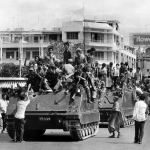
The Khmer Rouge was a communist revolutionary group that seized control of Cambodia in April 1975. The rise of the Khmer Rouge in Cambodia was facilitated by the war in neighbouring Vietnam. In 1951 Vietnamese communists, working with Cambodian supporters, formed the Khmer People’s Revolutionary Party (KPRP). The KPRP was intended to be a Cambodian communist party, though in its early years it was controlled by Vietnamese communists. By the late 1950s, Cambodians had begun to take up leadership positions in the party. One of its Cambodian leaders, a history teacher named Saloth Sar, wanted to reform and radicalise the movement. Sar joined the KPRP’s central committee in 1960 and became the party’s de facto leader in February 1963. During this period the KPRP was twice reformed, becoming the Workers’ Party of Kampuchea (WPK) in 1960. By the late 1960s, many newspapers were referring to Cambodian communists as the Khmer Rouge or ‘Red Khmers’, a term apparently coined by Norodom Sihanouk.
In mid-1963 Saloth Sar and his followers, facing arrest by Cambodian government forces, fled the capital Phnom Penh. They relocated to remote north-east Cambodia and linked up with their North Vietnamese and Viet Cong allies. With Vietnamese support, the Khmer Rouge established a base camp. Under Sar’s leadership, the party became more militant and radical. In 1966 the WPK re-formed again as the Communist Party of Kampuchea (CPK). Its explicit aim became revolution rather than political reform. Like the followers of Mao Zedong in China, the CPK abandoned traditional Marxist ideology. The only path to a classless, communal society, its leaders argued, was to empower Cambodia’s peasant farmers and eradicate all vestiges of Western influence, intellectualism and technology. During the mid-1960s the CPK worked on recruiting, training its members and gathering arms and supplies.
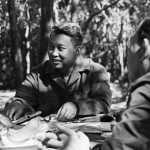
The Khmer Rouge began attacking government forces in January 1968. These attacks intensified after pro-American general Lon Nol seized control of the Cambodian government in a March 1970 coup. Widespread opposition to Lon Nol, as well as the fatalities and damage caused by American bombing, helped increased popular support for the Khmer Rouge. By 1972 the Khmer Rouge had more than 30,000 regular soldiers and more than 100,000 reservists. As the Khmer Rouge’s numbers grew, it was able to drive back government forces and claim more territory. By the start of 1975, it was clear the Khmer Rouge would soon be in control of the entire country. On April 1st, as Khmer Rouge forces approached the capital Phnom Penh, Lon Nol resigned and fled Cambodia. Twelve days later the United States military launched Operation Eagle Pull, a brief mission to evacuate American diplomats, foreigners and some Cambodian officials from Phnom Penh.
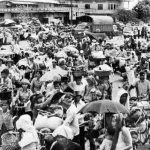
The Khmer Rouge gained control of Phnom Penh on April 17th, a fortnight before Saigon fell to the North Vietnamese Army (NVA). It was the first time a capital city had been captured by communist forces since the Korean War. The Khmer Rouge arrived in the city around noon. Dressed mainly in black, its soldiers were well armed but noticeably young, some in their early teens. A few engaged in looting but they seemed focused and well disciplined. Most residents, pleased to be finally rid of Lon Nol, cheered and welcomed the victors. The tone changed later in the afternoon when the Khmer Rouge began firing weapons into the air and ordering people out of buildings and into the streets. Children were pulled from schools, the elderly from their homes, even patients in the middle of surgical procedures were forced onto the road, still bleeding from wounds and incisions. Phnom Penh was at risk of a counter-revolutionary attack and American bombing, they were told, so the city would be evacuated for three days. For many Cambodians it would be more than three years before they returned to Phnom Penh; most would never return at all.
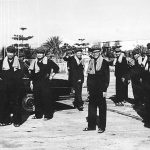
The Khmer Rouge also set about identifying foreigners and either arresting them or chasing them out of Cambodia. They immediately abolished the royal government and restored Norodom Sihanouk, then living in exile in China, as head of state. Sihanouk returned to Cambodia in September 1975 and became a roving ambassador for the Khmer Rouge. The real decisions, however, were made by the Khmer Rouge hierarchy, or Angkar (‘Organisation’). The leadership of Angkar was much less visible than that of other dictatorial regimes; orders and information were passed down the line to functionaries rather than disseminated as propaganda. The Khmer Rouge leader, Saloth Sar, did not foster a personality cult and gave only occasional speeches. The Khmer Rouge maintained a cloak of secrecy around its leadership, variously referring to Sar as Pol Pot, ‘Brother Number One’ or ‘One with the Gun’. In January 1976 the Khmer Rouge finally gave their new regime some political form, announcing a new constitution and renaming Cambodia as Democratic Kampuchea.
The Khmer Rouge’s social transformations were even more radical. Mimicking the French Revolution, Pol Pot and his followers declared their April 1975 victory as ‘Year Zero’. Cambodia’s history, along with its Western corruption and technical advances, would be ‘wound back’ and started again – under the tutelage of the Khmer Rouge. Pol Pot’s aim was to construct a classless, communal society, unhindered by foreign influences, middle-class intellectualism and non-communist ideas. Schools and colleges were closed, foreign embassies were seized and Buddhist pagodas were destroyed. Cambodia’s legal system and courts were virtually abolished; justice would instead be dispensed by the Khmer Rouge’s ‘death squads’ or its ‘re-education camps’. Millions of people were frog-marched out of Phnom Penh and other cities, which the Khmer Rouge called “hives of bourgeois corruption”. Cambodians with higher education or professional training were singled out for immediate execution. Others were put to work in the fields and forced to labour from dawn to dusk, usually without adequate food, rest or medical care. Books were burned; money was destroyed; communication infrastructure like television, radio and telephone wires were all dismantled.
“I came to join the revolution, not to kill the Cambodian people. Look at me now. Am I a violent person? No. So, as far as my conscience and my mission were concerned, there was no problem … There’s what we did wrong and what we did right. The mistake is that we did some things against the people — by us and also by the enemy — but the other side, as I told you, is that without our struggle there would be no Cambodia right now.”
Pol Pot
The Khmer Rouge’s social experiments were accompanied by a murderous state-run campaign that can only be described as political genocide. Anyone faintly suspected of being a potential enemy of the revolution was whisked away, tortured and murdered with pickaxes, their bodies disposed of in mass graves. The primary targets were individuals associated with the old regime: politicians, military personnel, bureaucrats, businessmen, priests and monks. But anyone deemed to be pro-American, pro-Western, pro-capitalist or an ‘intellectual’ – including academics, lawyers, doctors, journalists, artists, teachers, students, even musicians and clerks – could find themselves being marched to the notorious ‘killing fields’. Just wearing Western clothing or spectacles was enough to raise suspicion. During the four years of Khmer Rouge rule between 1.2 and 2.2 million Cambodians and foreigners died, either at the hands of Pol Pot’s murder squads or from starvation and disease.
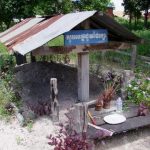
In December 1978 Democratic Kampuchea was invaded by almost a quarter million soldiers of the Socialist Republic of Vietnam. Without foreign allies or an industrial base to supply their military, the Khmer Rouge was hopelessly outgunned by Vietnamese planes, tanks and armoured vehicles. Phnom Penh fell to the Vietnamese in just two weeks, forcing Pol Pot and his followers to seek refuge in western Cambodia. They would remain in these jungle hideouts for two decades, leading a small but persistent insurgency against the new order. The Vietnamese eventually withdrew from Cambodia in 1989. An October 1991 peace agreement reformed the Cambodian state and scheduled elections for mid-1993. The Khmer Rouge, by now down to a few thousand insurgents, interfered with elections but could not prevent the formation of a new government. By 1996 Pol Pot had lost most of his supporters and was in poor health. He died in April 1998.

1. The Khmer Rouge (‘Red Khmers’) was a name given to the Communist Party of Kampuchea, a radical revolutionary group that seized control of Cambodia in April 1975.
2. After gaining control of Phnom Penh soldiers of the Khmer Rouge ordered the city to be evacuated, forcing locals to march into the countryside.
3. The Khmer Rouge government (or Angkar) abolished the old government, restored Norodom Sihanouk as titular head of state and established the nation of Democratic Kampuchea (January 1976).
4. The new regime attempted a radical social and economic transformation, eradicating entire classes, purging technology and recreating Cambodia as a purely agricultural economy.
5. As a result of Khmer Rouge policies, up to 2.2 million people were killed or starved to death. The Khmer Rouge was forced from power after Vietnamese forces invaded Cambodia in December 1978.
© Alpha History 2018. Content on this page may not be republished or distributed without permission. For more information please refer to our Terms of Use.
This page was written by Jennifer Llewellyn, Jim Southey and Steve Thompson. To reference this page, use the following citation:
J. Llewellyn et al, “The Khmer Rouge”, Alpha History, accessed [today’s date], https://alphahistory.com/vietnamwar/khmer-rouge/.
